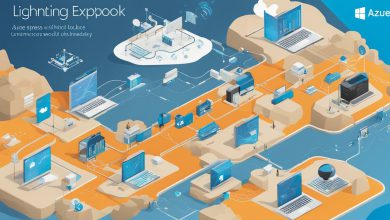
Welcome to our comprehensive guide on container security in the context of DevSecOps. As organizations increasingly adopt containerization to improve application deployment and delivery, securing containers becomes a crucial aspect of their DevSecOps strategy. Docker and Kubernetes have emerged as popular containerization platforms that offer various security features for container deployments.
In this article, we will explore container security in DevSecOps, and delve into the best practices for securing Docker containers and Kubernetes clusters. We will also highlight the importance of adopting a collaborative approach to container security, with development, security, and operations teams working in unison.
Key Takeaways
- Container security in DevSecOps is critical for safeguarding containerized applications.
- Docker and Kubernetes are popular platforms for containerization that offer various security features.
- Adopting best practices for securing Docker containers and Kubernetes clusters is crucial for ensuring secure container deployments.
- A collaborative approach between development, security, and operations teams is needed to ensure container security in DevSecOps.
Understanding Container Security in DevSecOps
Container security is a critical aspect of DevSecOps, and it’s essential to explore best practices to ensure secure container deployment. As more organizations adopt container technologies such as Docker and Kubernetes for containerizing their applications, they must also understand the specific challenges and risks posed by this approach.
Best practices for container security must consider the collaborative approach between development, security, and operations teams. Containers are designed to be lightweight, but this very characteristic can create security risks if not properly secured. Security must be baked into the container development and deployment pipeline, and all teams must work together to ensure that the containerized applications are secure.
Some of the best practices for container security include:
- Conducting a vulnerability scan of the images before deployment
- Isolating containers from the host and other containers
- Managing container images and ensuring they come from trusted sources
- Ensuring containers are running with the least amount of privileges
- Monitoring and logging container activity for suspicious behavior
Container security measures must extend beyond container isolation and image security. It’s essential to adopt a DevOps container security approach that includes continuous security testing and monitoring throughout the development and deployment lifecycle. Security checks should be automated wherever possible to enable faster identification and resolution of security issues.
Adopting these best practices for container security in DevOps can help organizations mitigate security risks associated with containerized applications and ensure secure container deployment.
Best Practices for Securing Docker Containers
Docker has revolutionized containerization and has become a staple in the DevOps toolkit. However, with the increased use of Docker containers comes the risk of security vulnerabilities. To ensure the security of Docker containers, it is essential to adopt best practices.
Image Security
The foundation of container security is image security. Docker images should be built from trusted sources and regularly updated to patch known vulnerabilities. Images should be scanned regularly for vulnerabilities using appropriate tools. This reduces the risk of unsecure images being deployed in production environments.
Container Isolation
Container isolation guarantees that containers are not impacted by vulnerabilities or attacks targeting other containers. This can be achieved by using resource limitations and network segmentation. Implementing container isolation ensures that containerized applications remain protected even when one of the containers is compromised.
Vulnerability Management
Vulnerability management involves identifying, assessing, and prioritizing vulnerabilities in Docker containers. This can include using software to scan images for vulnerabilities and implementing a mitigation strategy for discovered vulnerabilities. This best practice ensures that Docker containers remain secure throughout their lifecycle.
Secure Configuration
Configurations for Docker containers should be optimized for security. Containers that are set up with default configurations can leave them vulnerable to attack. A best practice is to use secure configurations formats, restrict access to the Docker daemon, and disable unnecessary services within the container to minimize the attack surface.
Adopting these best practices will maximize the security of Docker containers and enhance your DevSecOps practices.
Ensuring Security in Kubernetes Clusters
Securing Kubernetes clusters is a critical aspect of container security in DevSecOps. With the complexity of managing and securing Kubernetes environments comes unique security considerations and challenges. Therefore, organizations must adopt best practices and guidelines to safeguard their Kubernetes clusters from potential threats.
Kubernetes Security Guidelines
When setting up a Kubernetes environment, it is essential to follow security guidelines to ensure that the cluster is properly secured. These guidelines include:
- Implementing strong access controls to limit who can interact with the cluster
- Utilizing network segmentation and isolation to prevent unauthorized access to the cluster
- Implementing pod security policies to ensure that only trusted containers are deployed to the cluster
- Enabling auditing and logging to detect and investigate potential security breaches
- Keeping the Kubernetes software up-to-date with the latest security patches
Container Security Measures
In addition to following security guidelines, organizations must also implement container security measures to protect their Kubernetes clusters. These measures include:
- Scanning container images for vulnerabilities before deployment
- Enforcing strict network policies to prevent unauthorized communication between containers
- Using namespaces to isolate containers and limit their permissions
- Implementing secrets management to securely store sensitive data such as passwords and keys
- Employing container runtime security solutions to detect and prevent attacks in real-time
By adhering to these best practices and guidelines, organizations can significantly enhance the security of their Kubernetes clusters and minimize the risk of potential security incidents.
Implementing DevSecOps Practices for Container Security
Container security is paramount in today’s DevOps environments. While securing containers may seem like a daunting task, adopting a DevSecOps approach can help organizations ensure that their containerized applications are resilient to cyber threats. DevOps container security is all about integrating security measures into the entire application development lifecycle. This section will explore best practices for container security and provide guidance on how to implement DevSecOps practices for secure container deployment.
Tip: When integrating container security practices into your DevOps workflow, it is essential to ensure that security is a shared responsibility across all teams, including developers, security professionals, and operations personnel. This collaborative approach will ensure that security is baked into the development and deployment pipeline, reducing the risk of cyber threats.
Best Practices for Container Security
When it comes to securing containers, best practices can be broken down into several categories:
| Category | Best Practices |
|---|---|
| Image Security | Only use trusted images from reputable sources. Scan images for vulnerabilities and malware before deployment. |
| Container Isolation | Ensure that containers are isolated from each other and from the host system. Use containerization technologies that provide built-in isolation. |
| Vulnerability Management | Regularly scan your containers and dependencies for known vulnerabilities and apply patches as needed. Automate vulnerability scanning and remediation as part of your DevOps workflow. |
| Secure Configuration | Configure your containers with secure settings and ensure that they are deployed using secure network and storage configurations. Adopt a zero-trust security model for container management. |
Tip: Automate container security testing to ensure that security is baked into the development and deployment pipeline. Continuous security testing can help you detect vulnerabilities early in the development cycle, allowing you to address them before they become major security risks.
Integrating DevSecOps Practices for Container Security
Integrating DevSecOps practices for container security can help organizations enhance the resiliency of their containerized applications. Here are some best practices to consider:
- Collaboration: Foster collaboration between development, security, and operations teams to ensure that security is baked into the entire development and deployment pipeline.
- Automation: Automate security testing and vulnerability management as part of your DevOps workflow to catch security issues early and reduce the risk of cyber threats.
- Continuous Monitoring: Implement continuous monitoring to detect security threats in real-time and respond to them quickly.
- Training: Provide training to developers, security teams, and operations personnel on container security best practices and emerging threats.
By adopting DevSecOps practices for container security, organizations can ensure that their containerized applications are secure and resilient to cyber threats.
Common Challenges and Solutions
Securing containerized applications can present unique challenges, particularly with respect to Docker and Kubernetes environments. Below are some common challenges organizations may encounter when implementing container security measures, as well as solutions and workarounds to address them.
Challenge: Image Vulnerabilities
One of the primary security concerns with Docker containers is image vulnerabilities. Images may contain outdated packages or libraries with known security flaws, leaving them vulnerable to exploitation by attackers.
Solution: To mitigate this risk, it’s essential to keep images up-to-date and regularly scan them for vulnerabilities using a tool like Docker Security Scanning. When using Kubernetes, implementing a pod security policy that requires images to come from trusted sources can also help minimize the risk of image vulnerabilities.
Challenge: Access Control
Ensuring proper access control within a Kubernetes environment can be challenging, particularly as cluster size and complexity grows. If access controls are not properly configured, unauthorized users may be able to access sensitive resources within the environment.
Solution: Implementing RBAC (Role-Based Access Control) is a best practice for managing access control in Kubernetes. This approach allows for fine-grained control over who can access specific resources and what actions they are authorized to perform. Additionally, rotating secrets and ensuring secure communication within the environment can further enhance access control measures.
Challenge: Configuration Management
Improper configuration of containers and Kubernetes clusters can leave them vulnerable to attacks. This can occur when default configurations are used or when configurations are not properly customized for the specific environment.
Solution: Following best practices for secure configuration is essential in mitigating these risks. This includes configuring containers with minimal privileges, restricting network access, and using secure communication protocols. Kubernetes provides additional tools and features for managing configuration, including ConfigMaps and Secrets.
Challenge: Continuous Monitoring
Continuous monitoring is critical for identifying and responding to security incidents in real-time. However, monitoring containerized environments can be challenging due to the highly dynamic nature of these environments.
Solution: Implementing automated tools for continuous monitoring can help organizations keep pace with the rapid changes in containerized environments. This includes tools for monitoring container activity, network traffic, and system logs. Using a SIEM (Security Information and Event Management) platform can also help organizations aggregate and analyze security-related data from across the environment.
By addressing these common challenges and implementing best practices for container security measures in Docker and Kubernetes environments, organizations can significantly enhance the security of their containerized applications.
Conclusion
Securing containerized applications is an essential component of DevSecOps, and best practices for container security can help organizations ensure their deployments remain secure and stable. By adopting Docker and Kubernetes best practices, organizations can prevent common security risks and minimize the potential for data breaches.
Remember, container security is not a one-time fix but an ongoing process that requires collaboration between development, security, and operations teams. Organizations can integrate security throughout the development and deployment pipeline by adopting a DevSecOps approach and leveraging automated security testing and continuous monitoring.
In conclusion, follow Docker and Kubernetes best practices to create a more secure and reliable containerized infrastructure. Don’t wait for a security incident to occur before acting on container security. Instead, take proactive measures to safeguard your data and maintain the integrity of your application environments.
FAQ
Q: What is the role of Docker and Kubernetes in container security?
A: Docker and Kubernetes play crucial roles in container security. Docker provides a secure runtime environment for containers, while Kubernetes helps manage and secure containerized applications at scale.
Q: What are the challenges associated with container security in DevSecOps?
A: Container security in DevSecOps poses unique challenges, including image vulnerabilities, container isolation, and secure configuration. It requires collaboration between development, security, and operations teams to ensure the secure deployment of containers.
Q: What are some best practices for securing Docker containers?
A: Best practices for securing Docker containers include image security, container isolation, vulnerability management, and secure configuration. These practices help mitigate security risks and ensure the integrity of containerized applications.
Q: How can Kubernetes clusters be secured?
A: Securing Kubernetes clusters involves implementing access controls, network security measures, pod security policies, and regular auditing. These security measures help protect the Kubernetes environment and the containerized workloads.
Q: How can DevSecOps practices be implemented for container security?
A: Implementing DevSecOps practices for container security involves integrating security throughout the development and deployment pipeline. This includes automated security testing, continuous monitoring, and collaboration between teams to ensure secure container deployments.
Q: What are some common challenges in implementing container security measures?
A: Common challenges in implementing container security measures include managing image vulnerabilities, ensuring secure configurations, and addressing security risks in Kubernetes environments. Solutions and workarounds are available to overcome these challenges.







